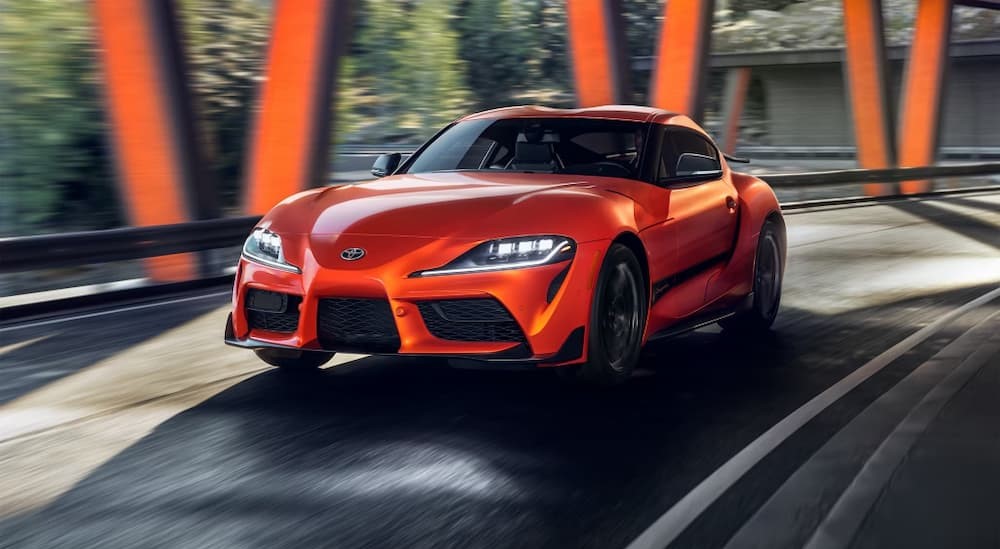Toyota’s performance credentials are often overshadowed by the brand’s reputation for reliability and value, but the Japanese automaker certainly knows its way around a sports car. Take the Toyota Supra, for example—introduced in the late 1970s, the Supra’s unique combination of performance and style has gone a long way toward injecting a little high-speed fun into the established Toyota formula. While Toyota’s RAV4 and Corolla regularly top the list of the world’s best-selling vehicles, it’s the Supra that has earned Toyota so much cred amongst those who see the posted speed limit as more of a suggestion.
The Supra returned to the Toyota lineup as the GR Supra in 2019 after a 17-year absence and has wasted no time in filling its trophy case with industry plaudits, including MotorWeek’s Best Sports Coupe award and Esquire’s Car of the Year. The Supra has also become a regular fixture on Car and Driver’s annual 10Best list, but all these awards belie one inconvenient truth: not all Supras are created equal. A quick survey of your local Toyota dealer will yield two primary versions of the Supra in the 2.0 and 3.0 trims.
With almost $10,000 separating the two models, there’s an expected gulf in performance. The 2.0 is virtually identical to the 3.0 in every way, except the one drivers tend to care about the most; as the numbers would suggest, the 2.0 is powered by a turbocharged 2.0-liter four-cylinder engine, while the 3.0 relies on a turbocharged 3.0-liter engine with two extra cylinders and all the performance-grade components required to effectively harness and transfer that power.
The entry-level has been largely overshadowed by the I-6 version, not to mention Toyota’s other sporty offering in the GR86, but does the 2.0 deserve more attention, or is it the weak link in the GR sports car lineup? I’ve compiled a short list of pros and cons to help drivers decide between the Supra 2.0, 3.0, and GR86 and see if the base model truly deserves the same Supra-latives.
Advantages
Cornering
When it comes to cornering, a smaller engine can actually be a good thing. We’re not saying the Supra 3.0 and GR86 don’t know their way through the curves, but the diminutive 2.0-liter is uniquely suited for carving through tight corners. This all comes down to the fact that the 2.0’s inline-four is located closer to the center of the car than the 3.0’s larger inline-six; this changes the car’s overall balance, putting less weight on the front axle and resulting in a tighter, more responsive ride.
This, combined with the smaller engine, actually makes the 2.0 more fun than the 3.0 in some important ways. Drivers have to earn that edge-of-your-seat feeling with the 2.0, forging a connection with the vehicle in order to get the most out of it. The 3.0 is almost a little too easy in comparison, leading to a more removed driving experience that—while thrilling—lacks some of the personality of the smaller 2.0.
The GR86 falls somewhere in the middle with a 2.4-liter engine that, combined with the sports car’s exceptionally low center of gravity, provides plenty of fun behind the wheel.
Price
The most obvious advantage of the Supra 2.0 would have to be the price. The entry-level sports car might not be able to produce as much power as the 3.0, but it’s otherwise virtually identical. That means drivers can enjoy some premium features like keyless entry, automatic-leveling LED headlights, and a full suite of advanced driver assistance systems (ADAS) like pre-collision avoidance with pedestrian detection and lane departure warning with steering assist without shelling out the extra $9,000 for the 3.0.
Then there’s the infotainment system. Both the 2.0 and 3.0 come standard with a rebranded version of BMW’s iDrive system crafted especially for Toyota. Routed through an 8.8-inch touchscreen, this infotainment system brings a little luxury flair to the reasonably priced model.
Those looking to upgrade the 2.0 or 3.0 can add the Safety and Technology package, which includes wireless Apple CarPlay and a host of additional ADAS features like rear cross-traffic alert, adaptive cruise control, blind-spot monitoring, and full parking sensors with emergency braking. The package even includes a little software designed especially for the Supra, dubbed Supra Connected Services.
With real-time traffic monitoring, remote services, and stolen-vehicle tracking, the Safety and Technology package allows the 2.0 to punch well above its weight for an additional charge of $3,485. That said, the 2.0 still lags behind the GR86 when it comes to affordability, but there’s simply no beating Toyota’s fastback coupe, which, even in the range-topping Trueno Edition, maxes out at just $36,240.
Tires
Both Supra models ride on sporty Michelin summer tires, but the ones found on the 2.0 have a larger sidewall than those on the 3.0. This can bring some real benefits when it comes to ride quality, braking, and straight-line launches, though the contact patch is technically still the same size as you’ll find on the 3.0. The GR86 also rides on tires with a larger sidewall, though making a direct comparison between the two different models is a little trickier. The budget-friendly sports car is offered with Michelin Pilot Sport 4 when upgrading to the Premium trim, putting a little more pep in the GR86’s step.
Launch Control
Achieving a drag strip-worthy start requires a little more than just mashing on the gas pedal. That approach can lead to a lot of wheelspin and hop, robbing a vehicle of vital traction and leading to a laggy start. Luckily, Toyota has engineered around this problem by outfitting the Supra 2.0 and 3.0 with Launch Control, a clever bit of software that drastically reduces wheelspin and hop by altering the vehicle’s torque, throttle, and gear settings.
Launch Control not only ensures your tires will maintain contact with the ground, but it can also be a useful failsafe to prevent the sort of over-revving that can result in long-term damage. Both versions of the Supra are available with Launch Control, though some experts say it’s a little more practical in the 2.0, where it’s not being asked to manage quite as much horsepower. The GR86 is not available with Launch Control, though the model’s Sport mode does serve a similar—if less effective—alternative.
Disadvantages
Power
We’ll start with the biggest and most obvious difference between the Supra 2.0, 3.0, and GR86: the engine. While both the 2.0 and 3.0 employ a little forced induction to squeeze maximum power out of their relatively small displacement engines, the 3.0 proves that an extra liter makes all the difference when it comes to performance.
The Supra 3.0-liter engine put out 382 hp and 368 lb-ft of torque, numbers that leave the 255-hp 2.0 choking on its big brother’s dust. The two models are a little closer in terms of torque, with the 2.0 only lagging behind the 3.0 by 73 lb-ft, but it’s hard to make a case for the smaller Supra engine from a pure performance perspective.
The 2.0 matches up a little better with the GR86, which it outshines by a decent margin in terms of both horsepower and torque. The GR86 maxes out at 228 hp and 184 lb-ft of torque, which shouldn’t be surprising considering this model costs $15,000 less than even the cheapest Supra.
That’s not to say that the GR86 can’t provide a few thrills; its lower curb weight (2,838 lbs to the Supra 2.0/3.0’s 3,181/3,400 lbs) does give it some decent acceleration, though its 6.1-second zero-to-sixty time is no match for either Supra which can reach the same speed in either 3.8 or 4.5 seconds.
Transmission
Drivers who prefer to row their own gears might feel a little stymied by the Supra 2.0. While the Supra 3.0 and GR86 are both available with a six-speed manual transmission, the Supra 2.0 is limited to the eight-speed automatic. While this certainly makes for less multitasking, the limited control is sure to be a dealbreaker for those purists who believe that a true sports car deserves a manual option.
But the absence of a manual transmission doesn’t mean the 2.0 is totally lacking in customization. Toyota has packed every Supra and GR86 with two drive modes that can deliver two very different on-road experiences. Want to maximize fuel economy and comfort? Normal mode is the way to go. For those looking for a more dynamic driving experience, there’s Sport mode, which adjusts the vehicle’s shifting, throttle response, transmission, and electronic power steering assist to deliver a more engaging ride.
When in Sport mode, the Supra 2.0 will offer improved handling and peppier acceleration and will hold each gear for just a little bit longer. Sure, it might come at the cost of fuel efficiency, but if you’re looking for a gas-sipping vehicle, there are plenty of other Toyotas to choose from.
Brakes and Wheels
If you want to test your driving prowess on a local track, the Supra 2.0 might be missing some essential hardware. The entry-level trim is offered with 18-inch wheels and 13-inch disc brakes paired with a single-piston caliper, which, while adequate for everyday driving, might be a little underwhelming when you’re in the mood to push the Supra to the limits.
The 3.0 is pretty well-outfitted in comparison, with 19-inch wheels and a set of 13.7-inch disc brakes, but it’s this model’s four-piston calipers that really set it apart in terms of performance. The GR86 comes with 18-inch wheels, Michelin Pilot Sport 4 tires, and a fairly standard set of 11.6-inch disc brakes, but those seeking a little extra stopping power can upgrade to the Trueno Edition to replace the standard setup with a set of Brembo brakes.
Mechanical vs Electronic
At first glance, it might seem like the Supra 2.0 and 3.0 are packing remarkably similar components, but it’s important to read the fine print. Take the limited-slip differentials (LSD), for example; designed to improve traction and limit wheelspin, LSDs are a fairly common feature on most performance and off-road models. The difference between the Supra 2.0 and 3.0 comes down to the design of the LSD.
Both models have them, but the 3.0’s is electronic, while the 2.0 relies on a more old-fashioned, mechanical approach. That means the 3.0’s LSD is a little more responsive and quick to jump into action when compared to the 2.0, which can be an important factor in more performance-minded applications.
Toyota has taken the same approach when it comes to the Supras dampers, outfitting the 2.0 with passive dampers and treating the 3.0 to fancier active dampers that can adjust in response to changing road conditions. The GR86 is built with traditional LSD and passive dampers, though upgrading to the Trueno Edition will see the dampers replaced with a premium setup from Sachs.
High Performance, High Tech, High Price
So, is the Supra 2.0 a worthwhile investment or a transparent cash grab from a brand looking to capitalize on this sports car’s reputation? It all depends on what you’re looking for. While the 2.0 might not be able to match the raw output of the 3.0, it does offer a well-rounded alternative that allows drivers to get a taste of the Supra experience without breaking the bank.
The smaller engine and higher tires improve overall drive quality and performance, while Toyota’s Launch Control is uniquely suited to the less powerful trim. Sure, the 2.0 will get beat by the 3.0 every time you take to the track, but the $10,000-plus price discrepancy can make a world of difference when it comes to accessibility.
Those looking to modify their 2.0 can put that extra $10,000 toward their own bespoke upgrades, making the 2.0 the perfect platform for your next project car or dedicated racer. Meanwhile, the GR86 offers the same sort of value but fails to match both Supra models in a few important ways. Ultimately it comes down to a matter of taste and budget, but I would say that if you’re considering a new Toyota sports car, the Supra 2.0 is certainly worth a test drive.






